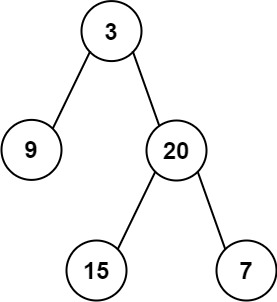12.06 二叉树中等题2
106. 从中序与后序遍历序列构造二叉树
给定两个整数数组 inorder 和 postorder ,其中 inorder 是二叉树的中序遍历, postorder 是同一棵树的后序遍历,请你构造并返回这颗 二叉树 。
示例 1:

输入:inorder = [9,3,15,20,7], postorder = [9,15,7,20,3] 输出:[3,9,20,null,null,15,7]
思路:后序遍历的数组中最后一个元素会是根节点,
有了根节点,可以在中序遍历数组中分出根节点的左子树和右子树,
即中序遍历数组中根节点左边的属于左子树,右边的属于右子树,即可分出左子树和右子树的中序遍历数组。
后序遍历数组中左子树和右子树的个数都要等于inorder数组的子树,即可分出左子树和右子树的后序遍历数组。
细节:根据思路可以用递归来做
/**
* Definition for a binary tree node.
* struct TreeNode {
* int val;
* TreeNode *left;
* TreeNode *right;
* TreeNode() : val(0), left(nullptr), right(nullptr) {}
* TreeNode(int x) : val(x), left(nullptr), right(nullptr) {}
* TreeNode(int x, TreeNode *left, TreeNode *right) : val(x), left(left), right(right) {}
* };
*/
class Solution {
public:
int findIndex(vector<int>& nums,int target)
{
for(int i=0;i<nums.size();i++)
{
if(nums[i]==target) return i;
}
//没有这个值
return -1;
}
TreeNode* buildTree(vector<int>& inorder, vector<int>& postorder) {
if(inorder.size()==0) return nullptr;
//查找根节点在中序遍历数组中的下标
int rootVal=postorder[postorder.size()-1];
auto rootIndex=findIndex(inorder,rootVal);
//分别为
//左子树的中序遍历数组 左子树的后续遍历数组
// 右子树的中序遍历数组 右子树的后续遍历数组
vector<int> leftInorder(inorder.begin(),inorder.begin()+rootIndex);
// vector<int> leftPostorder(postorder.begin(),postorder.begin()+leftInorder.size());
vector<int> leftPostorder(postorder.begin(),postorder.begin()+rootIndex);
vector<int> rightInorder(inorder.begin()+rootIndex+1,inorder.end());
vector<int> rightPostorder(postorder.begin()+rootIndex,postorder.end()-1);
TreeNode* root=new TreeNode(rootVal,
buildTree(leftInorder,leftPostorder),
buildTree(rightInorder,rightPostorder));
return root;
}
};-
时间复杂度:O(n),其中 n是树中的节点个数。.
98. 验证二叉搜索树
给你一个二叉树的根节点 root ,判断其是否是一个有效的二叉搜索树。
有效 二叉搜索树定义如下:
- 节点的左子树只包含 小于 当前节点的数。
- 节点的右子树只包含 大于 当前节点的数。
- 所有左子树和右子树自身必须也是二叉搜索树。
示例 1:

输入:root = [2,1,3] 输出:true
思路:中序遍历二叉搜索树后的结果会是单调递增且无重复的。只需要对中序遍历的结果进行判定即可。
用双指针判断是否为单调递增的数组。
/**
* Definition for a binary tree node.
* struct TreeNode {
* int val;
* TreeNode *left;
* TreeNode *right;
* TreeNode() : val(0), left(nullptr), right(nullptr) {}
* TreeNode(int x) : val(x), left(nullptr), right(nullptr) {}
* TreeNode(int x, TreeNode *left, TreeNode *right) : val(x), left(left), right(right) {}
* };
*/
class Solution {
public:
void midOrder(TreeNode* root,vector<int>& midResult)
{
if(!root) return;
else
{
midOrder(root->left,midResult);
midResult.push_back(root->val);
midOrder(root->right,midResult);
}
}
bool isValidBST(TreeNode* root) {
//中序遍历的结果 得是单调递增且无重复的
vector<int> midResult;
midOrder(root,midResult);
//判断是否是单调递增且无重复的
if(midResult.size()<=1) return true;
int left=0,right=1;
while(right<midResult.size())
{
if(midResult[left]>=midResult[right]) return false;
left++;
right++;
}
return true;
}
};-
时间复杂度:O(n),其中 n为二叉树的节点个数。二叉树的每个节点最多被访问一次,因此时间复杂度为 O(n)。
